Types of Kitchen Bugs (With Pictures) – Identification Guide
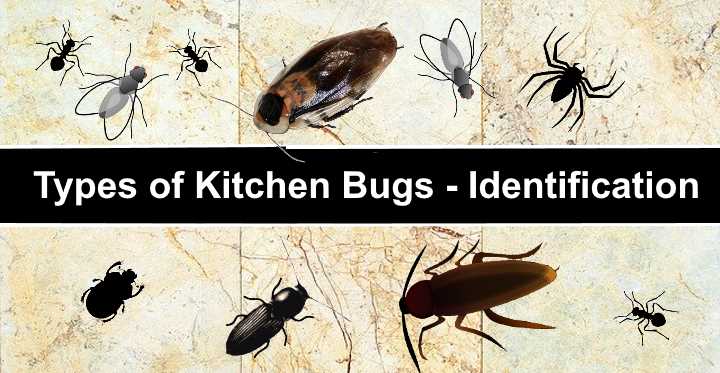
Many types of bugs can become a significant nuisance in kitchens. Tiny black kitchen bugs like fruit flies, gnats, or drain flies can hover around your face or land on food. Disgusting kitchen bugs such as rice weevils, flour beetles, or pantry bugs lay eggs in stored dry food products that become infested with larvae. Or you could notice disease-carrying cockroaches or other nasty bugs scurrying across your floor.
Unfortunately, noticing one or two tiny bugs in the kitchen usually means more kitchen pests are lurking somewhere else. Therefore, identifying black or brown bugs in the kitchen is crucial in eradicating them. In addition, common kitchen bugs often prefer a specific habitat or food source, and knowing this can help you prevent the small bugs from returning.
This article is a guide to identifying common types of kitchen bugs that you could find in your pantry, in cabinets, under countertops, and in drains. Pictures of kitchen-infesting flies, beetles, weevils, spiders, and roaches will help you identify nasty pests that might be infesting your home.
How to Identify Kitchen Bugs
The best way to identify a bug infestation in your kitchen is to note the insect’s size, number of legs, shape, and whether it has wings. For example, small black pantry beetles and weevils may look like tiny specks. Or small fruit flies and gnats may hover around rotting fruit and the trash can.
The Most Common Kitchen Bugs
The most common bugs in the kitchen are gnats, tiny beetles, various types of pantry weevils, cockroaches, odorous house ants, fruit flies, and Indianmeal moths. You’ll find the annoying insects under kitchen appliances, sinks, cabinets, or in drains and especially in damp areas under sinks.
What Do Kitchen Bugs Eat?
Tiny brown and black bugs in your kitchen eat almost anything. These common kitchen pests feed on dried foodstuffs, leftover crumbs on countertops, or rotting fruit. The creepy-crawly kitchen bugs will eat processed food, dried cereals, flour, dried fruits, cake mix, pasta, rice, and even spices.
Some tiny kitchen mites will munch through cardboard packaging to eat the contents. And it’s not uncommon to find little bugs in unopened packets of cereals, rice, pasta, and grains. Likewise, the minute weevils, beetles, or fruit flies can get into food in the processing centers.
Unfortunately, once the tiny house bugs have infested your kitchen foodstuffs, they lay eggs, and then larvae hatch and continue doing more damage.
How to Get Rid of Kitchen Bugs
The first step to eliminating tiny bugs from your kitchen is to trash any contaminated foods. Even if you only notice a few fruit flies or pantry bugs, the chances are that food is infested with microscopic eggs or tiny white worms. So, squishing the bugs may not get rid of them for good.
The next step to rid your kitchen of tiny bugs is to clean and disinfect surfaces. To do this, vacuum your kitchen cabinets, ensuring to get into all nooks and crannies. After that, wipe down all surfaces with hot, soapy water to kill off any remaining bugs and sanitize countertops and cabinets.
Mixing equal parts of white vinegar and water can create a kitchen bug spray that kills tiny pests on contact and disinfects surfaces. You can also use the spray as a preventative measure to kill bugs on kitchen countertops.
After eradicating bugs from your kitchen, preventing them from returning is crucial. To do this, keep dried foodstuffs — rice, grains, flours — in airtight, plastic or glass containers. Also, it’s a good idea to always wipe away crumbs, spillage, and leftover food from kitchen surfaces. And during warm weather, when fruit flies and gnats are present, keep fruit and vegetables in the refrigerator.
You could also freeze food before storing it to help keep your kitchen free of beetles, weevils, gnats, and other nasty bugs.
Types of Kitchen Bugs (With Pictures) – Identification
Kitchen bugs refer to any unwanted creepy-crawling insect you don’t want in your home. The tiny pests could be six-legged insects like beetles or weevils, eight-legged spiders, flying gnats, or the larvae of any type of bug.
Gnats (Sciaridae) – Tiny Black Flying Bugs in the Kitchen
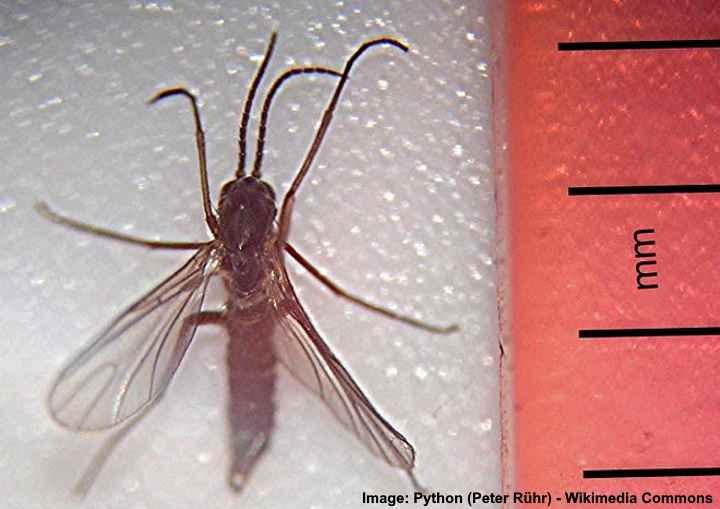
Gants are small black flying bugs that can be found in damp places in the kitchen
Gnats in the kitchen look like tiny black flies that are attracted to moist, damp places. The tiny black flying kitchen bugs can be exceedingly annoying as they fly around your face, land on food, and emerge from the trash can when you open the lid. Sometimes called fungus gnats, the annoying tiny flying bugs are often found in dark places with high humidity.
You can get rid of kitchen gnats by putting an old banana skin in a jar, sealing the opening with plastic wrap, poking a few holes in the top, and securing it with a rubber band. The sweet, fermenting banana skin attracts the gnats, and they can’t get back out.
Kitchen Bug Identification
Kitchen gnats are typically black with slender bodies and hover around houseplants, trash cans, and dirty dishes.
Fruit Flies (Drosophila melanogaster) in the Kitchen

Fruit flies are tiny brown kitchen bugs that especially like sweet rotten fruit
Fruit flies are tiny brown bugs found in the kitchen that are about 0.125” (3 mm) long. Up close, you’ll see that the flying bugs have a brown front portion, black rear end, and red eyes. The little brown bugs lay eggs near fermenting foods, and the emerging larvae will also feed on rotting organic material.
Get rid of fruit flies by keeping damaged or cut fruit and vegetables in sealed containers or the refrigerator. A trap for killing gnats will also work for fruit flies.
Kitchen Bug Identification
Fruit flies are tiny oval-shaped bugs with a tan-colored thorax and black abdomen.
Drain Flies (Psychodidae)
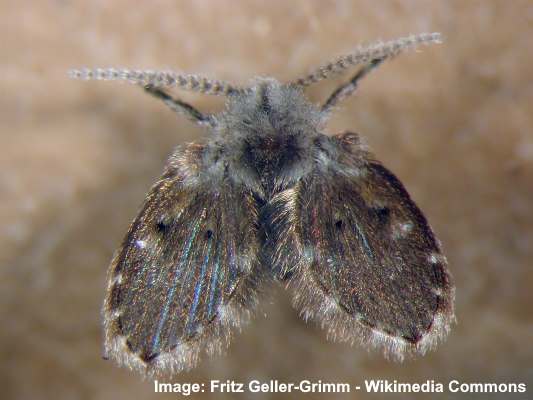
Drain flies are tiny flying kitchen bugs with gray-brown furry look
Drain flies are annoying flying bugs that can be found in houses. Drain flies look like tiny dark gray or brown moths with an oval body, stumpy wings, and long, segmented antennae. The small dark-winged insects are recognized by their short, hopping flight pattern. As their name suggests, you’ll often find drain flies emerging from kitchen sink drains or floor drains.
The best way of eliminating drain flies is to clean pipes and drains thoroughly from slime accumulation. Drain fly larvae can swim in water, so getting rid of them for good is challenging.
Kitchen Bug Identification
Adult drain flies or moth flies are small, dark gnat-like flies measuring 0.16” (4 mm) long.
Common House Flies (Musca domestica)

Houseflies are common kitchen bugs that can cause infestation in large quantities
The common housefly is a significant nuisance in the kitchen. The annoying flies have large compound eyes, a dull gray, sometimes iridescent body, and translucent wings. The small buzzing pest has an erratic flight pattern, and it is often seen on windows and feeding on rotten food.
A female can lay up to 100 tiny white eggs that hatch within 12 to 24 hours. An issue with houseflies is that they can carry disease and contaminate food.
The best way of getting rid of houseflies is to keep food stored in secure containers, remove food residue, don’t leave pet food out, and keep garbage cans closed.
Kitchen Bug Identification
The common housefly is a dark-colored fly with a grayish abdomen and large reddish eyes. The flying kitchen bugs measure up to 0.27” (7 mm) long.
Indian Meal Moth (Plodia interpunctella)
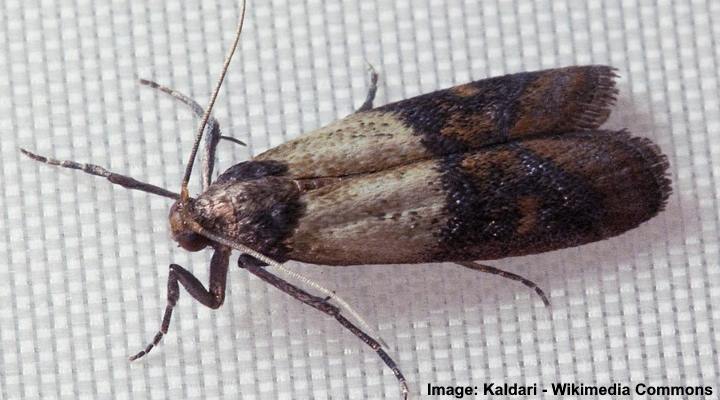
The brown and gray Indianmeal moth is commonly found in kitchens and pantries in grain products
Indian meal moths are brown flying insects that flutter in kitchens. The house moths infest food in kitchens when they lay eggs on foodstuffs. The emerging larvae look creamy-white or pale brown and measure 0.5” (12 mm) long.
The pesky white house bugs feed on all sorts of food and leave behind feces, cast skins, and eggshells.
If you suspect Indian meal moths in your kitchen, discard contaminated food or freeze it. It’s also a good idea to put food in sealed containers and don’t leave food out overnight.
Kitchen Bug Identification
Indianmeal moths have an easily recognizable wing pattern where half of their wings are a bronze or reddish-brown color.
Tiny Brown Bugs in The Kitchen
Tiny brown bugs in the kitchen are usually collectively called pantry bugs. The brown or black bugs can be beetles or weevils and live in dried, stored foodstuffs. They can be so small that they are hard to spot.
Spider Beetles

The American spider beetle (Mezium americanum) is a little brown beetle that looks like a small spider
Spider beetles are recognized by their distinctive oval-shaped body, six legs, two long antennae, and black or brown color. The spider-like kitchen bugs measure 0.04” to 0.19” (1 – 5 mm) long. Although not common, the tiny kitchen bugs or mites can quickly contaminate grain-based foodstuffs.
Signs of spider beetle activity are holes in food containers, webbing in packages of grain products, and possible shed skin in food.
Kitchen Bug Identification
Spider beetles are identified by their rounded abdomen, brown color, and three pairs of legs.
Sawtoothed Grain Beetle (Oryzaephilus surinamensis)
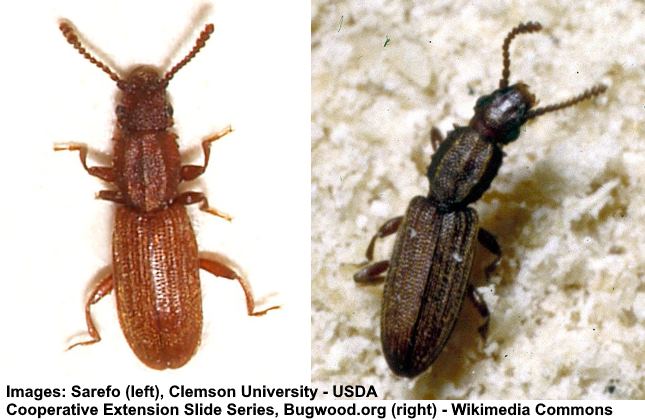
Sawtoothed grain beetles are tiny bugs in the kitchen that range in color from rusty brown to dark brown
The sawtoothed grain beetle is a common kitchen bug with identifiable saw-like teeth on the sides of its body. The tiny brown kitchen bug has a slender appearance, two clubbed antennae, and a flat reddish-brown or dark brown body. Sawtoothed grain larvae are yellowish-white with a brown head.
Sawtoothed grain beetles usually feed on dried cereals, breakfast foods, sugar, and fried meats. To eliminate these pesky brown beetles, always clear away spilled flour, keep noodles, cereal, and pasta, and dried products in sealed storage containers.
Kitchen Bug Identification
Sawtoothed grain beetles are tiny, slender brown kitchen bugs measuring 0.12” (3 mm) long.
Drugstore Beetle (Stegobium paniceum)
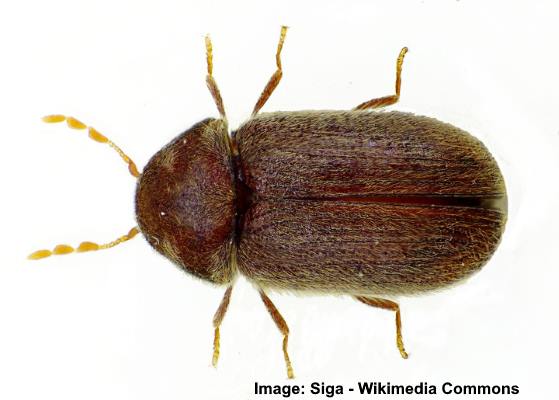
The tiny brown drugstore beetle has a hard shell and is commonly found in packets of dried food products in the kitchen
The drugstore beetle is a small reddish-brown beetle with a cylindrical body and fine groves along its wing cases. Pictures of this brown kitchen bug show that it looks like a coffee bean. The larvae of this tiny brown bug are creamy-white with a brown head and measure up to 0.2” (5 mm) long.
Also called the bread beetle or biscuit beetle, you’ll often find the tiny kitchen bug infesting flour and spices. Like eradicating most pantry bugs, discarding contaminated foods, and sanitizing surfaces usually eliminate these pests.
Kitchen Bug Identification
The identifying feature of a drugstore beetle is a brown cylindrical grooved body that is 0.88” to 0.13” (2.25 – 3.5 mm) long.
Rice weevils (Sitophilus oryzae)
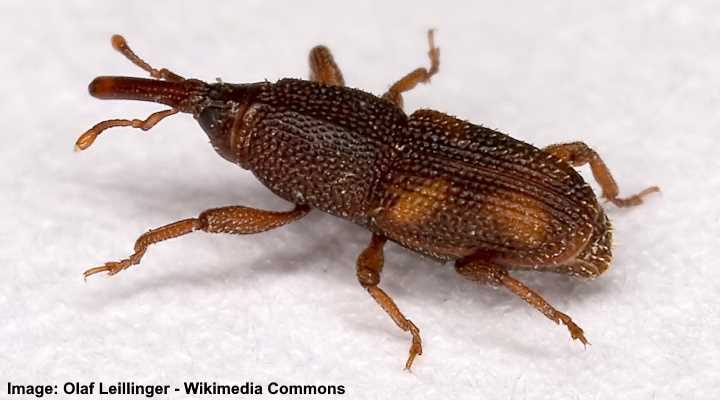
The rice weevil is a type of small brown beetle identified by its elongated snout
Rice weevils are small brown kitchen bugs with a long snout and pitted reddish spots on their backs. The recognizable feature of these bugs is their snout, which is about one-third of its body’s length. The tiny weevil larvae are plump, cream-colored, and live inside grain kernels.
Rice weevils can get into your home in several ways. Their eggs are sometimes in dried flower arrangements, birdseed, beanbags, pasta, or plant seeds. Usually, freezing items for a week kills any bugs.
Kitchen Bug Identification
Rice weevils are easy to identify due to their long, protruding snouts and slender body with a pitted appearance. The brown kitchen bugs are about 0.11” (3 mm) long.
Flour Beetles (Tribolium confusum and Tribolium castaneum)
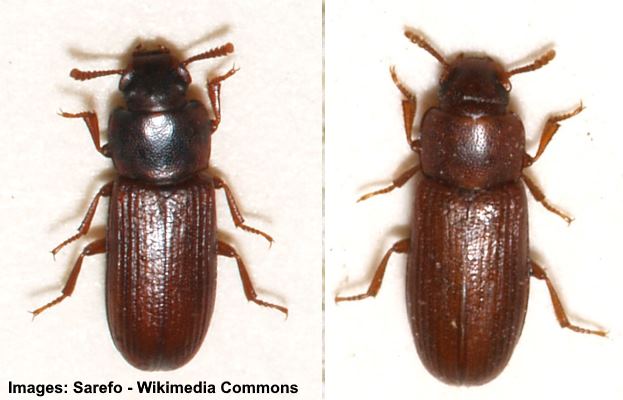
Flour beetles (Tribolium confusum on the left and Tribolium castaneum on the right) are small brown pantry bugs commonly found in flour and in the kitchen cabinets
Flour beetles are a common reddish-brown bug in kitchens with an elongated oval body. Identifying features of the brown bug are two short, clubbed antennae, copper-colored legs, and longitudinal grooves along its back. You may find these tiny brown bugs in flour, stored grain products, dried fruit, nuts, and beans.
There are various types of flour beetles that can be found indoors. The confused flour beetle (Tribolium confusum) gets its name because it’s confused with the red flour beetle (Tribolium castaneum). The destructive flour beetle (Tribolium destructor) is a dark brown or black kitchen bug that also infests packets of flour and grains.
Kitchen Bug Identification
Flour beetles are identified by their shiny reddish-brown to dark brown, flattened bodies, oval shape, and short, clubbed antennae. Flour beetles measure between 0.11” to 0.23” (3 – 6 mm) long.
Bean weevils (Acanthoscelides obtectus)
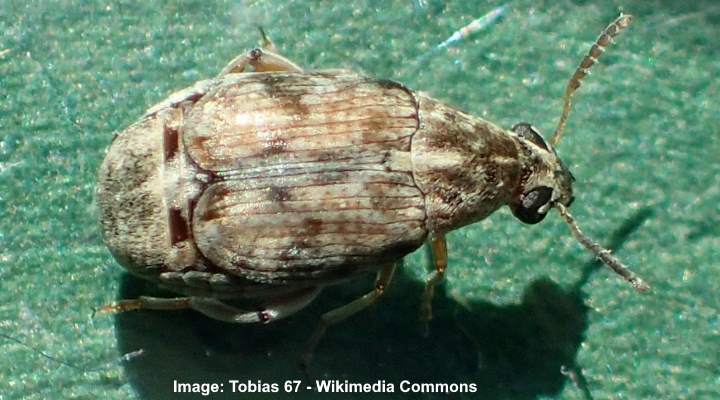
The bean weevil has mottled brown and beige body without the elongated snout typical to weevils
The bean weevil is a type of grayish-brown kitchen bug with an oval body and mottled pattern on its back. The tiny, egg-shaped weevil ranges in color from dark to light brown with irregular patterns. One way to tell this pesky weevil apart from other kitchen weevils is its lack of a snout.
Bean weevils generally attack legumes, beans, and peas. The small brown bugs measure between 0.78” to 0.2” (2 – 5 mm) long.
Kitchen Bug Identification
Bean weevils have a tear-shaped light tan to dark brown body, characterized by mottled patterns and a pointed, triangular head.
Common Kitchen Pests
A kitchen is a place where we cook food, eat, and spend time with friends. Therefore, it is vital to keep kitchens free from bugs that can contaminate countertops, foodstuffs, and other items. Here are descriptions of more kitchen pests that could be in your home.
Ants in the Kitchen
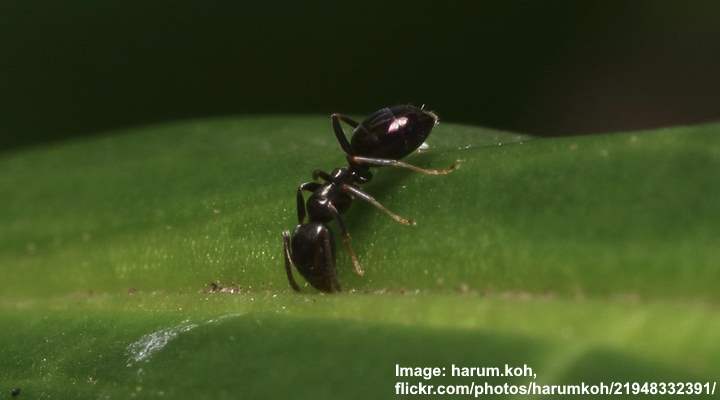
The black household ant (Ochetellus glaber) can also be dark brown, depending on the species
Ants are tiny black bugs often found in the kitchen as they scavenger for food and water. Common household ants are typically odorous house ants, little black ants, Argentine ants, or Pharaoh ants. The bugs have a slender body, tiny waist, and bulbous abdomen. Typically, spotting one ant in your kitchen means a colony nearby.
To get rid of house ants for good from your kitchen requires destroying the nest. If the colony of ants is nesting in your yard, caulk all entry points to your home, no matter how tiny. You may have to use traps to kill them and reduce their numbers indoors.
Kitchen Bug Identification
Ants are easy to recognize due to their ultra-thin waist, relatively large abdomen, and bent antennae. Ants can be red or black, and some ants develop wings and can fly into your kitchen.
Cockroaches

Common roach (German roach/Blattella germanica) on the left and American roach (Periplaneta americana) on the right
Cockroaches are common reddish-brown kitchen bugs with slender, flattened, oval bodies, six legs, and long antennae. The disease-carrying insects are usually found in dark places and scurry away when you turn on a light or open a cupboard door. The light- to dark-brown bugs tend to prefer moist, dark places.
To get rid of cockroaches from your kitchen, it’s vital to ensure there is no excess moisture or food debris on countertops or under appliances.
You can make a cockroach trap with boric acid, flour and sugar to form a dough. Place the traps at the backs of drawers and cabinets and under sinks and stoves. The sugar attracts the kitchen bugs, and the boric acid kills them.
Kitchen Bug Identification
Cockroaches are identified by their reddish-brown color. Common household cockroaches (Blattella germanica) measure 0.6” (15 mm) in length.
Silverfish (Lepisma saccharinum)

Silverfish is a creepy bug commonly found in damp places in the kitchen
Silverfish is a slithering, silvery-gray insect with a metallic shine. The unusual tiny kitchen bug has a tapered abdomen, giving it a fish-like appearance. This silvery bug is usually seen wiggling across floors. The nocturnal bugs are generally a sign of high humidity of over 75 percent.
Ways of getting rid of silverfish include reducing humidity, fixing any leaks, and clearing clutter. Also, sprinkling diatomaceous earth (DE) in dry places where silverfish are common can help to kill them. It is best to sprinkle DE along baseboards, under sinks and bathtubs in the evening and do this for several evenings in a row.
Kitchen Bug Identification
Silverfish are identified by their silvery coating, oval-shaped bodies that taper to a point, and the way the tiny bugs slither across floors.
Learn how to identify common types of pantry bugs.
Related articles:
